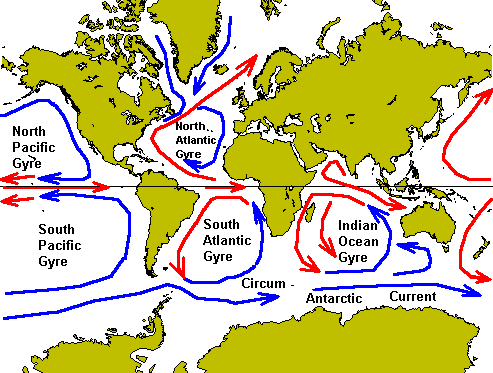VIEW: Ocean Currents (BrainPop)
Surface Currents
Surface currents in the oceans move in response to global winds. Therefore, the direction of the surface currents is dependent upon the direction the wind is blowing. There are three bands of global winds in each of the northern and southern hemispheres. The trade winds are closest to the equator and blow from east to west; they drive the ocean surface currents from the east to west as well. The prevailing westerlies are found at mid-latitudes and move from west to east, creating surface currents that also move in that direction. The polar easterlies are closest to the poles and blow from east to west, pushing surface currents westward.

However, ocean surface currents do not blow in a straight line like the global winds because their movement is impeded by the continents and affected by Earth's rotation (Coriolis Effect). Instead, they flow in a circular pattern, referred to as gyres. Gyres in the northern hemisphere flow in a clockwise direction while gyres in the southern hemisphere flow in a counterclockwise direction.

Theromohaline Currents
A network of surface and deep ocean currents constantly circulate ocean water from one side of the globe to another.They are known as the thermohaline currents. Thermohaline refers to how changes in temperature ("thermo") and salinity ("haline") cause ocean currents.
Two characteristics affect water's density: temperature and salinity. In general, colder water is more dense that warmer water and salty water is more dense than freshwater. Changes to ocean water's temperature and salinity cause the ocean currents, which occur as a result of these changes in density. Temperature and light availability decrease with depth in the world's oceans, while water density and pressure increase with depth.
The unequal distribution of solar radiation on Earth's surface is one of the most important factors of thermohaline circulation. The Sun warms surface water near the equator. This warm water then moves as a current from the tropics toward higher latitudes, where it cools and transfers its heat to the atmosphere. One such current, known as the Gulf Stream, originates in the Gulf of Mexico and carries warm water across the northern Atlantic Ocean. The heat it releases helps to keep northwest Europe warmer than other regions at the same latitude.
Water moving northward cools, and as a result it becomes denser than the warmer water arriving from the tropics behind it. The formation of sea ice at high latitudes also affects the density of water. As ice forms at the ocean surface, salt ions are left behind, increasing the water's salinity, which in turn, increases the water's density. Colder and saltier, this dense water begins to sink. Warm water from the tropics moves in to replace it at the surface, and it, too, begins to cool. The cold water descends to the ocean bottom where it forms what oceanographers call the North Atlantic Deep Water, a mass of water that fills most of the deep Atlantic basin.
In the Indian Ocean, upwelling occurs as deep water warms and rises to the surface, where it warms even more and provides moisture for monsoon rains. This warm water then swings back and joins the other surface currents flowing in from the Pacific. Together, they pass the Cape of Good Hope and head north, past the west coast of Africa and Europe, toward Iceland in the North Atlantic, where the 1,000-year journey begins again. The circulation of surface and deep ocean currents circulates heat and nutrients throughout the world's oceans.
After you have completed this part of the lesson, you can check the box for this lesson piece in the course to mark it as complete